CSC00240 Data Communication Networks: uSoft.com Network Solution
VerifiedAdded on 2023/04/21
|14
|2777
|129
Report
AI Summary
This report provides a network solution for uSoft.com, a private biomedical software development company, focusing on redesigning the headquarters' LAN to meet business and technical goals, including improved communication, enhanced security, and scalability. The report includes a detailed analysis of the existing network, user requirement engineering, a logical and physical network design, and an IP addressing plan. The proposed solution utilizes a three-layer hierarchical model (core, distribution, and access) and incorporates VLANs to manage network traffic and access control across six departments: software development, solution design, customer support, sales, finance, and human resources. VPN configuration and access control lists are recommended for network security, and the design accounts for future growth by allocating additional IP address space. The report concludes with a physical and logical network diagram, illustrating the network topology and IP address assignments.

Running head: DATA COMMUNICATION AND NETWORKS
Data Communication and Networks
Name of the Student
Name of the University
Author’s Note
Data Communication and Networks
Name of the Student
Name of the University
Author’s Note
Paraphrase This Document
Need a fresh take? Get an instant paraphrase of this document with our AI Paraphraser
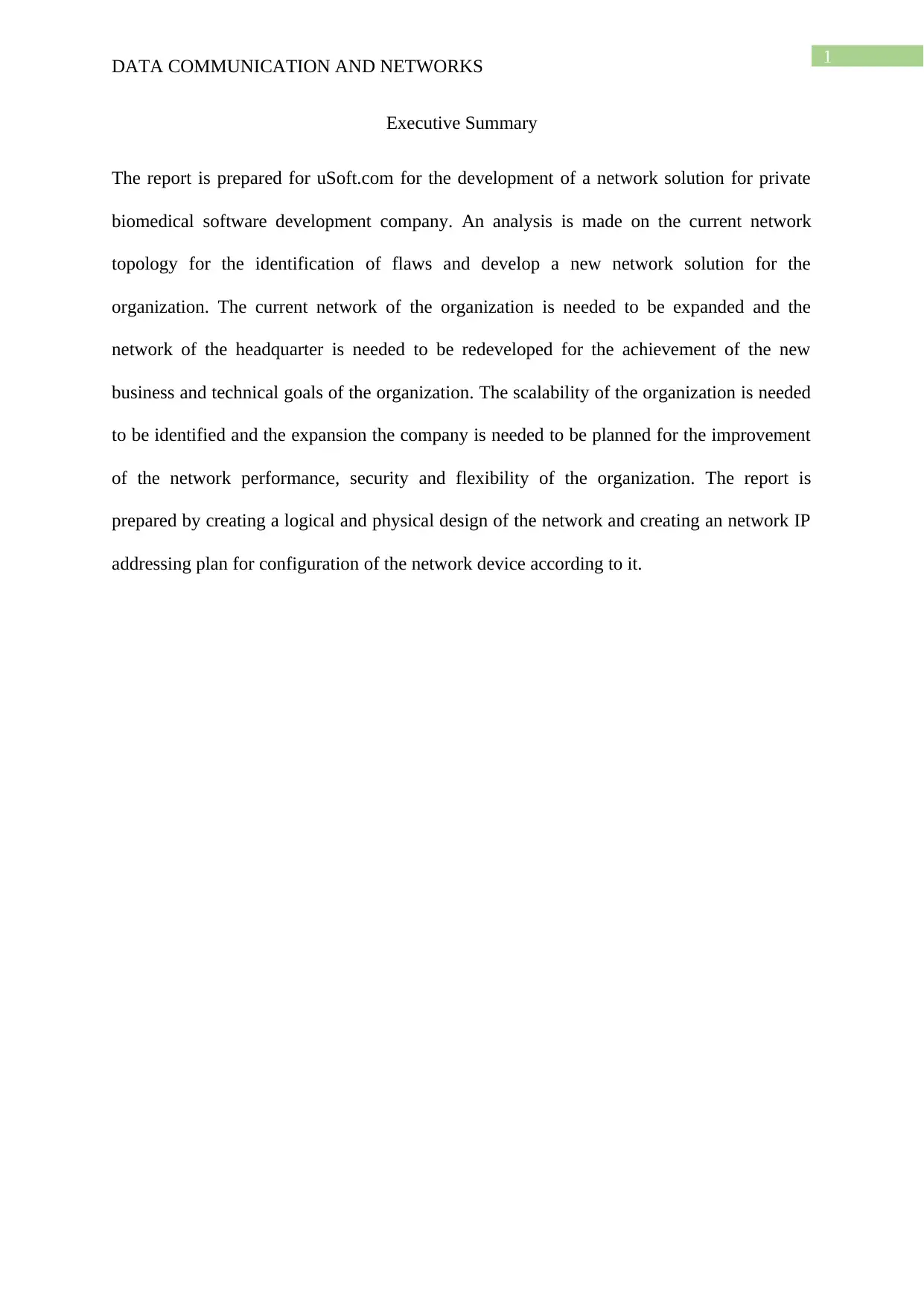
1
DATA COMMUNICATION AND NETWORKS
Executive Summary
The report is prepared for uSoft.com for the development of a network solution for private
biomedical software development company. An analysis is made on the current network
topology for the identification of flaws and develop a new network solution for the
organization. The current network of the organization is needed to be expanded and the
network of the headquarter is needed to be redeveloped for the achievement of the new
business and technical goals of the organization. The scalability of the organization is needed
to be identified and the expansion the company is needed to be planned for the improvement
of the network performance, security and flexibility of the organization. The report is
prepared by creating a logical and physical design of the network and creating an network IP
addressing plan for configuration of the network device according to it.
DATA COMMUNICATION AND NETWORKS
Executive Summary
The report is prepared for uSoft.com for the development of a network solution for private
biomedical software development company. An analysis is made on the current network
topology for the identification of flaws and develop a new network solution for the
organization. The current network of the organization is needed to be expanded and the
network of the headquarter is needed to be redeveloped for the achievement of the new
business and technical goals of the organization. The scalability of the organization is needed
to be identified and the expansion the company is needed to be planned for the improvement
of the network performance, security and flexibility of the organization. The report is
prepared by creating a logical and physical design of the network and creating an network IP
addressing plan for configuration of the network device according to it.
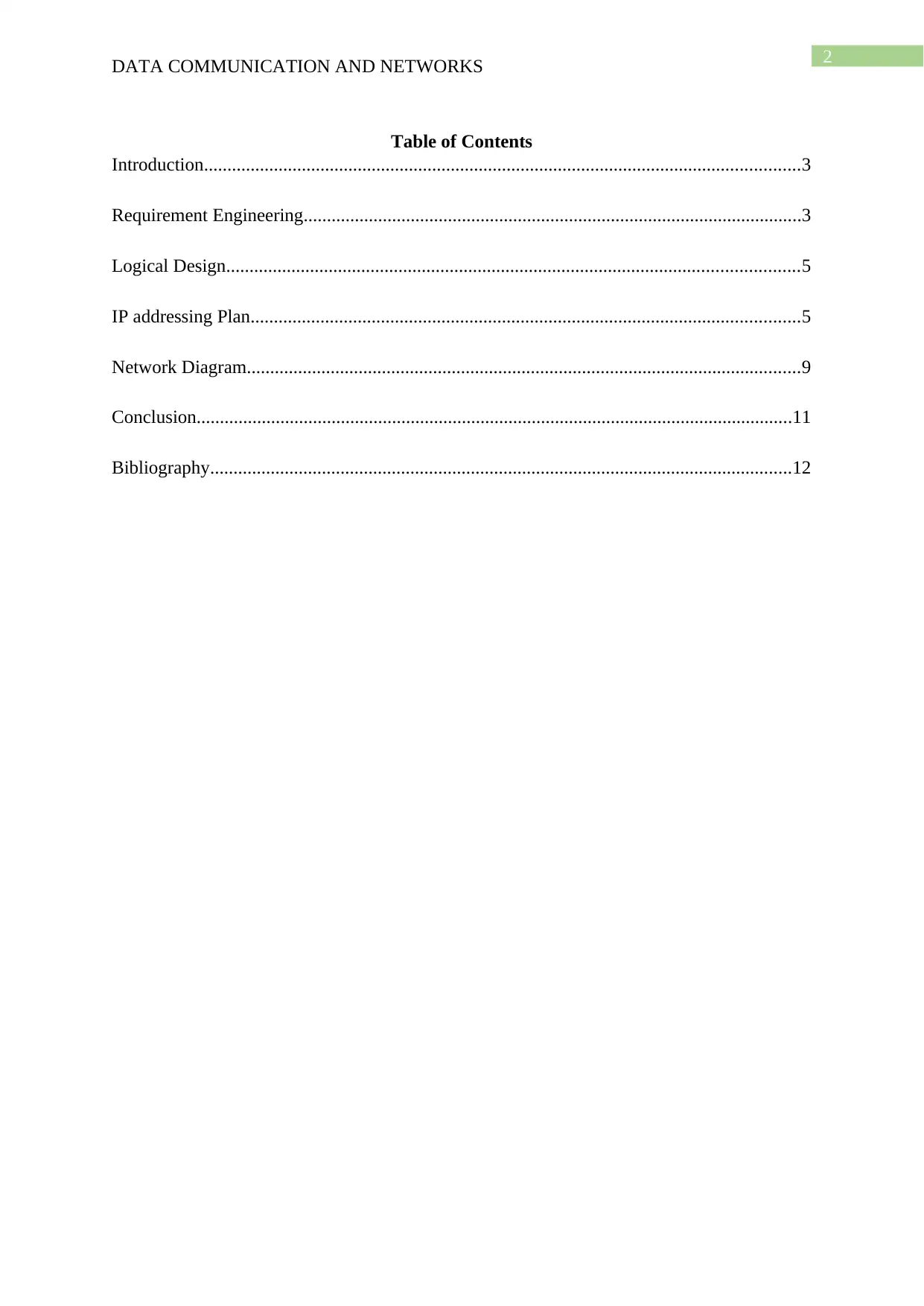
2
DATA COMMUNICATION AND NETWORKS
Table of Contents
Introduction................................................................................................................................3
Requirement Engineering...........................................................................................................3
Logical Design...........................................................................................................................5
IP addressing Plan......................................................................................................................5
Network Diagram.......................................................................................................................9
Conclusion................................................................................................................................11
Bibliography.............................................................................................................................12
DATA COMMUNICATION AND NETWORKS
Table of Contents
Introduction................................................................................................................................3
Requirement Engineering...........................................................................................................3
Logical Design...........................................................................................................................5
IP addressing Plan......................................................................................................................5
Network Diagram.......................................................................................................................9
Conclusion................................................................................................................................11
Bibliography.............................................................................................................................12
⊘ This is a preview!⊘
Do you want full access?
Subscribe today to unlock all pages.

Trusted by 1+ million students worldwide
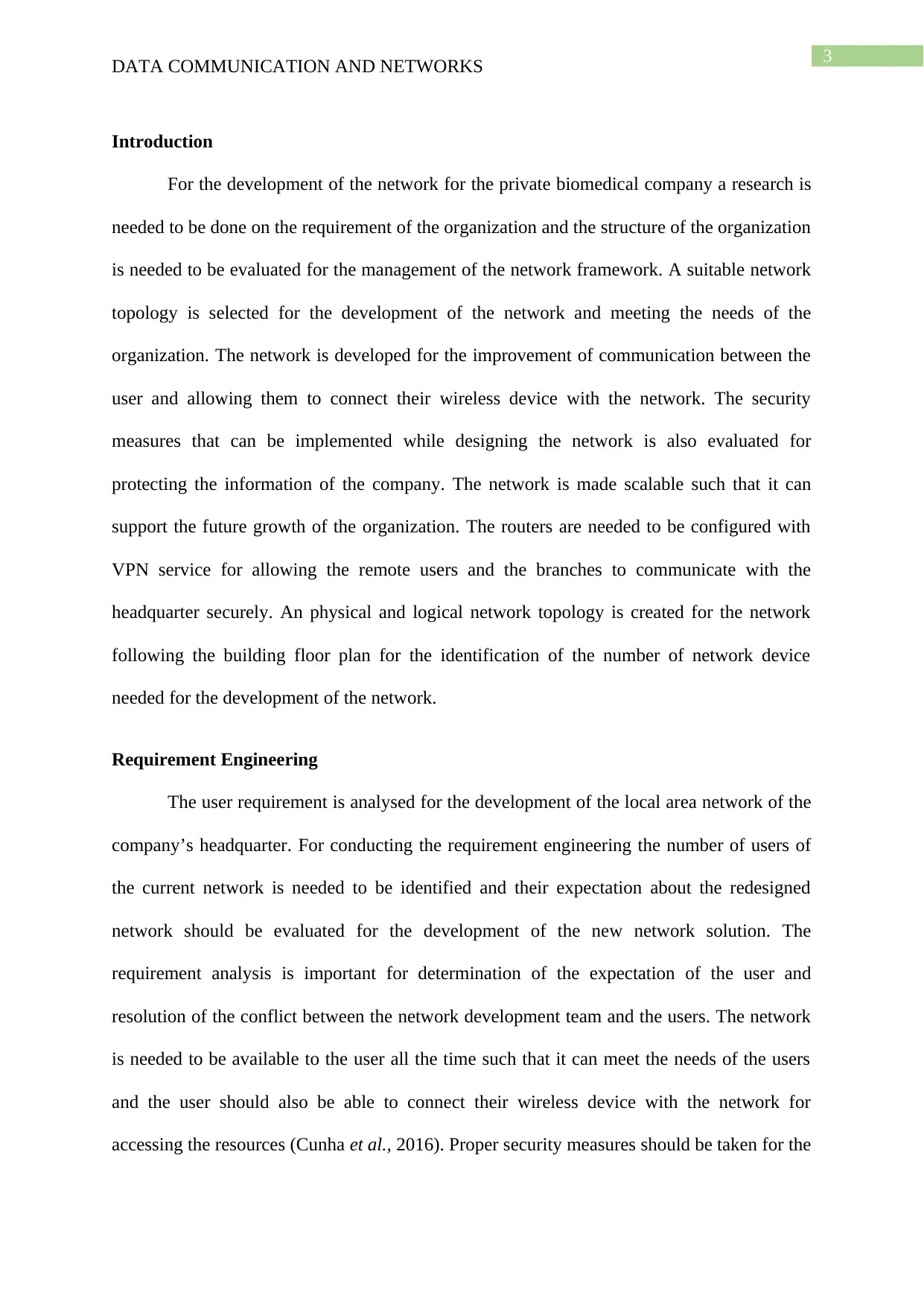
3
DATA COMMUNICATION AND NETWORKS
Introduction
For the development of the network for the private biomedical company a research is
needed to be done on the requirement of the organization and the structure of the organization
is needed to be evaluated for the management of the network framework. A suitable network
topology is selected for the development of the network and meeting the needs of the
organization. The network is developed for the improvement of communication between the
user and allowing them to connect their wireless device with the network. The security
measures that can be implemented while designing the network is also evaluated for
protecting the information of the company. The network is made scalable such that it can
support the future growth of the organization. The routers are needed to be configured with
VPN service for allowing the remote users and the branches to communicate with the
headquarter securely. An physical and logical network topology is created for the network
following the building floor plan for the identification of the number of network device
needed for the development of the network.
Requirement Engineering
The user requirement is analysed for the development of the local area network of the
company’s headquarter. For conducting the requirement engineering the number of users of
the current network is needed to be identified and their expectation about the redesigned
network should be evaluated for the development of the new network solution. The
requirement analysis is important for determination of the expectation of the user and
resolution of the conflict between the network development team and the users. The network
is needed to be available to the user all the time such that it can meet the needs of the users
and the user should also be able to connect their wireless device with the network for
accessing the resources (Cunha et al., 2016). Proper security measures should be taken for the
DATA COMMUNICATION AND NETWORKS
Introduction
For the development of the network for the private biomedical company a research is
needed to be done on the requirement of the organization and the structure of the organization
is needed to be evaluated for the management of the network framework. A suitable network
topology is selected for the development of the network and meeting the needs of the
organization. The network is developed for the improvement of communication between the
user and allowing them to connect their wireless device with the network. The security
measures that can be implemented while designing the network is also evaluated for
protecting the information of the company. The network is made scalable such that it can
support the future growth of the organization. The routers are needed to be configured with
VPN service for allowing the remote users and the branches to communicate with the
headquarter securely. An physical and logical network topology is created for the network
following the building floor plan for the identification of the number of network device
needed for the development of the network.
Requirement Engineering
The user requirement is analysed for the development of the local area network of the
company’s headquarter. For conducting the requirement engineering the number of users of
the current network is needed to be identified and their expectation about the redesigned
network should be evaluated for the development of the new network solution. The
requirement analysis is important for determination of the expectation of the user and
resolution of the conflict between the network development team and the users. The network
is needed to be available to the user all the time such that it can meet the needs of the users
and the user should also be able to connect their wireless device with the network for
accessing the resources (Cunha et al., 2016). Proper security measures should be taken for the
Paraphrase This Document
Need a fresh take? Get an instant paraphrase of this document with our AI Paraphraser
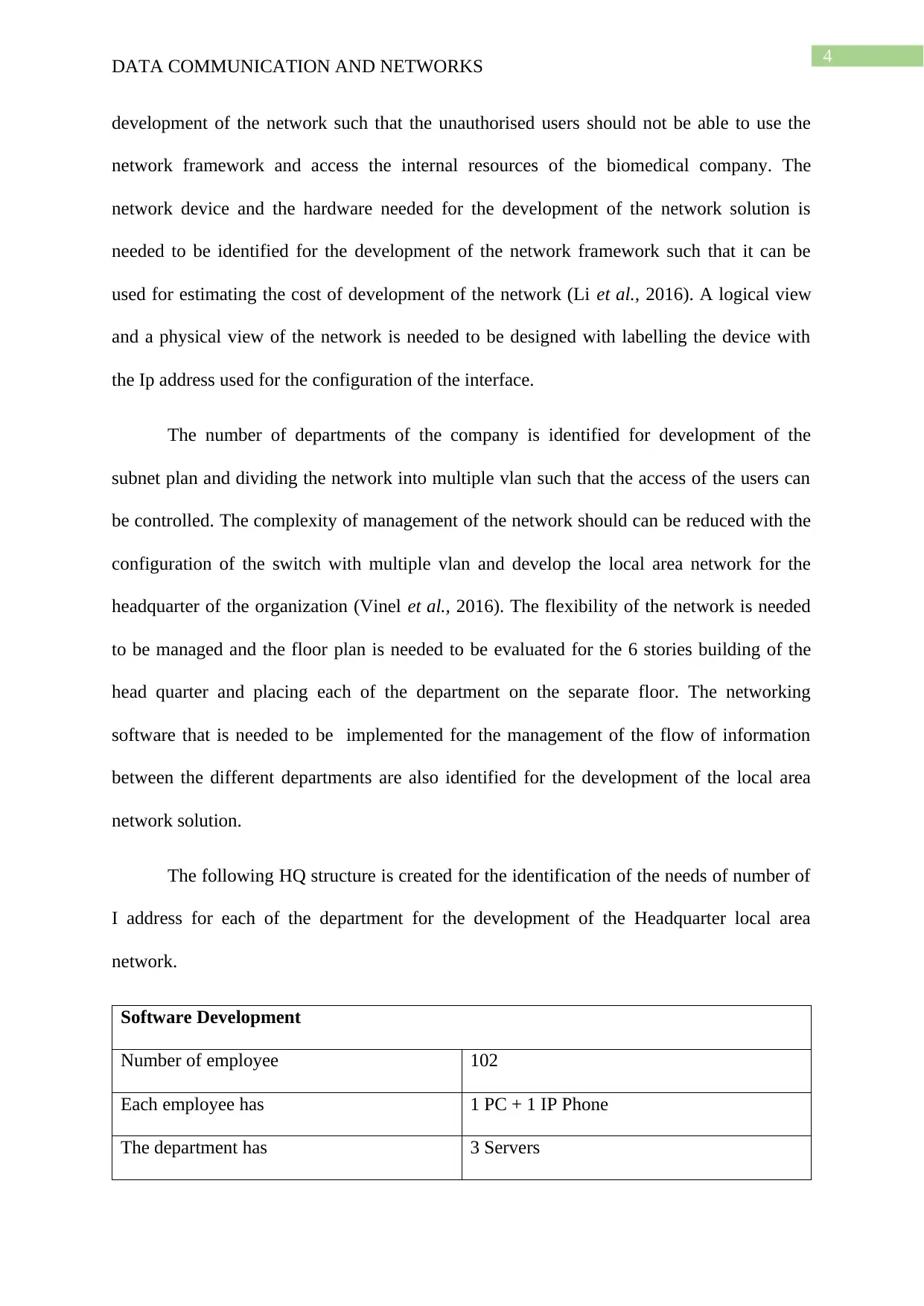
4
DATA COMMUNICATION AND NETWORKS
development of the network such that the unauthorised users should not be able to use the
network framework and access the internal resources of the biomedical company. The
network device and the hardware needed for the development of the network solution is
needed to be identified for the development of the network framework such that it can be
used for estimating the cost of development of the network (Li et al., 2016). A logical view
and a physical view of the network is needed to be designed with labelling the device with
the Ip address used for the configuration of the interface.
The number of departments of the company is identified for development of the
subnet plan and dividing the network into multiple vlan such that the access of the users can
be controlled. The complexity of management of the network should can be reduced with the
configuration of the switch with multiple vlan and develop the local area network for the
headquarter of the organization (Vinel et al., 2016). The flexibility of the network is needed
to be managed and the floor plan is needed to be evaluated for the 6 stories building of the
head quarter and placing each of the department on the separate floor. The networking
software that is needed to be implemented for the management of the flow of information
between the different departments are also identified for the development of the local area
network solution.
The following HQ structure is created for the identification of the needs of number of
I address for each of the department for the development of the Headquarter local area
network.
Software Development
Number of employee 102
Each employee has 1 PC + 1 IP Phone
The department has 3 Servers
DATA COMMUNICATION AND NETWORKS
development of the network such that the unauthorised users should not be able to use the
network framework and access the internal resources of the biomedical company. The
network device and the hardware needed for the development of the network solution is
needed to be identified for the development of the network framework such that it can be
used for estimating the cost of development of the network (Li et al., 2016). A logical view
and a physical view of the network is needed to be designed with labelling the device with
the Ip address used for the configuration of the interface.
The number of departments of the company is identified for development of the
subnet plan and dividing the network into multiple vlan such that the access of the users can
be controlled. The complexity of management of the network should can be reduced with the
configuration of the switch with multiple vlan and develop the local area network for the
headquarter of the organization (Vinel et al., 2016). The flexibility of the network is needed
to be managed and the floor plan is needed to be evaluated for the 6 stories building of the
head quarter and placing each of the department on the separate floor. The networking
software that is needed to be implemented for the management of the flow of information
between the different departments are also identified for the development of the local area
network solution.
The following HQ structure is created for the identification of the needs of number of
I address for each of the department for the development of the Headquarter local area
network.
Software Development
Number of employee 102
Each employee has 1 PC + 1 IP Phone
The department has 3 Servers
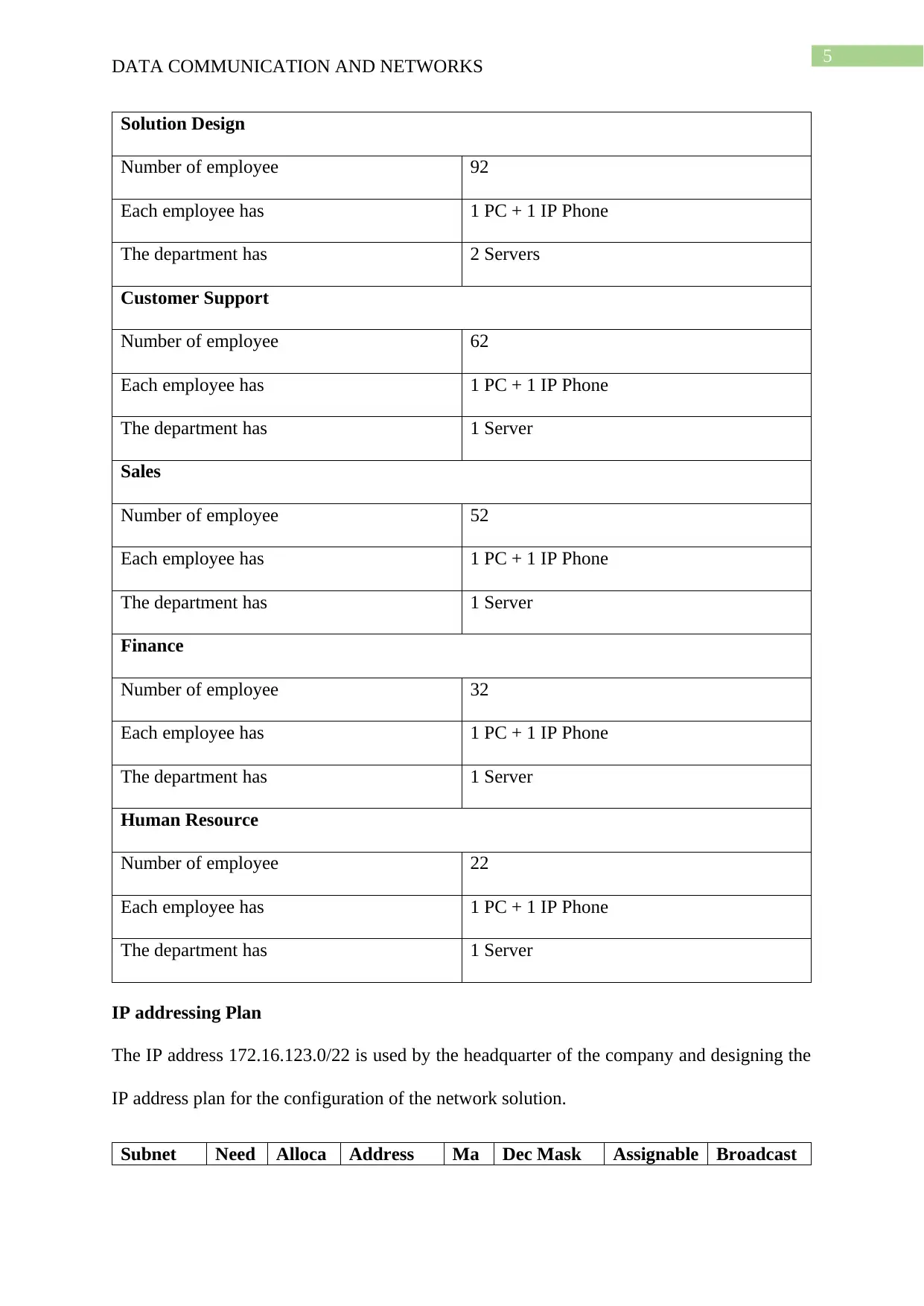
5
DATA COMMUNICATION AND NETWORKS
Solution Design
Number of employee 92
Each employee has 1 PC + 1 IP Phone
The department has 2 Servers
Customer Support
Number of employee 62
Each employee has 1 PC + 1 IP Phone
The department has 1 Server
Sales
Number of employee 52
Each employee has 1 PC + 1 IP Phone
The department has 1 Server
Finance
Number of employee 32
Each employee has 1 PC + 1 IP Phone
The department has 1 Server
Human Resource
Number of employee 22
Each employee has 1 PC + 1 IP Phone
The department has 1 Server
IP addressing Plan
The IP address 172.16.123.0/22 is used by the headquarter of the company and designing the
IP address plan for the configuration of the network solution.
Subnet Need Alloca Address Ma Dec Mask Assignable Broadcast
DATA COMMUNICATION AND NETWORKS
Solution Design
Number of employee 92
Each employee has 1 PC + 1 IP Phone
The department has 2 Servers
Customer Support
Number of employee 62
Each employee has 1 PC + 1 IP Phone
The department has 1 Server
Sales
Number of employee 52
Each employee has 1 PC + 1 IP Phone
The department has 1 Server
Finance
Number of employee 32
Each employee has 1 PC + 1 IP Phone
The department has 1 Server
Human Resource
Number of employee 22
Each employee has 1 PC + 1 IP Phone
The department has 1 Server
IP addressing Plan
The IP address 172.16.123.0/22 is used by the headquarter of the company and designing the
IP address plan for the configuration of the network solution.
Subnet Need Alloca Address Ma Dec Mask Assignable Broadcast
⊘ This is a preview!⊘
Do you want full access?
Subscribe today to unlock all pages.

Trusted by 1+ million students worldwide
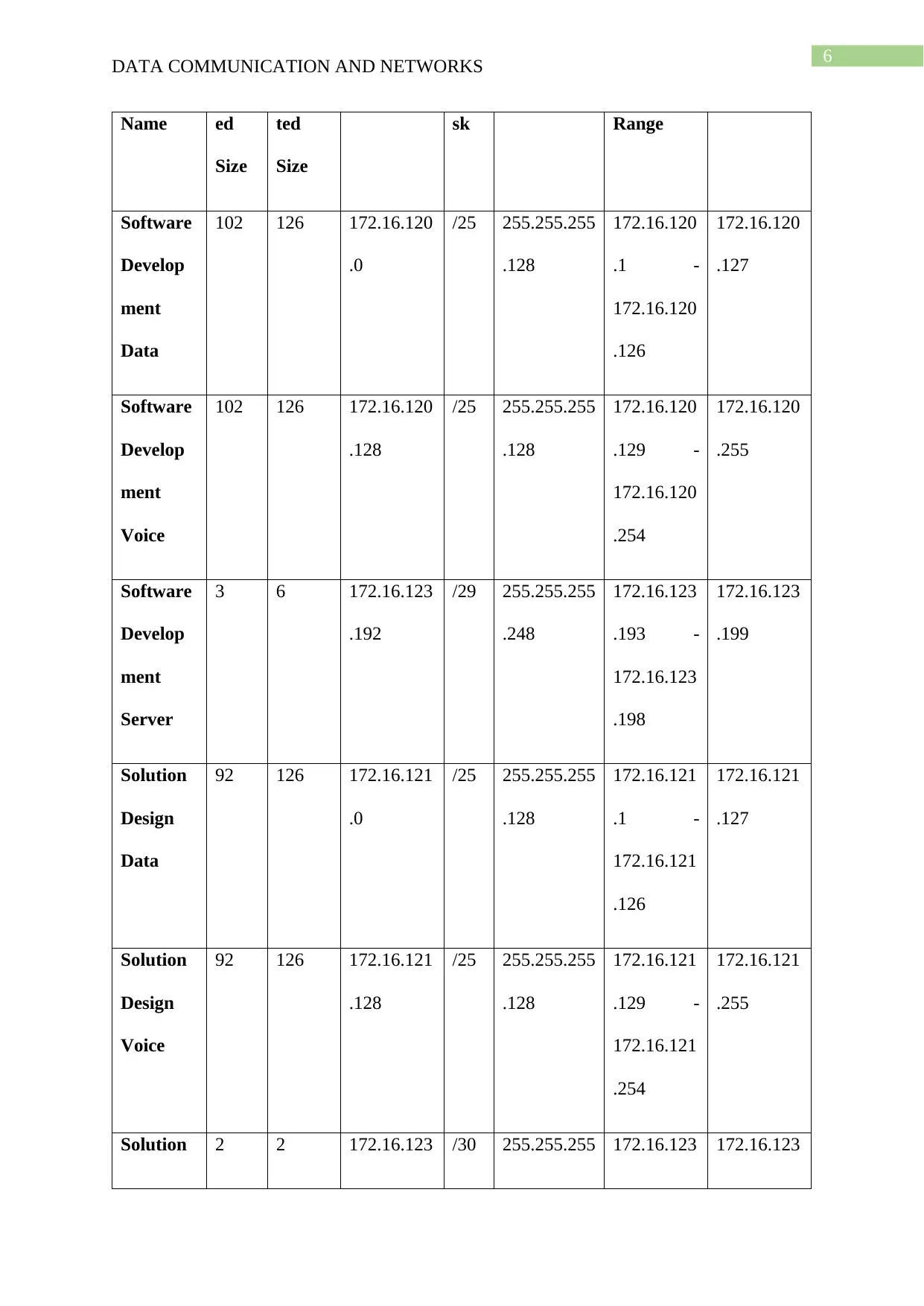
6
DATA COMMUNICATION AND NETWORKS
Name ed
Size
ted
Size
sk Range
Software
Develop
ment
Data
102 126 172.16.120
.0
/25 255.255.255
.128
172.16.120
.1 -
172.16.120
.126
172.16.120
.127
Software
Develop
ment
Voice
102 126 172.16.120
.128
/25 255.255.255
.128
172.16.120
.129 -
172.16.120
.254
172.16.120
.255
Software
Develop
ment
Server
3 6 172.16.123
.192
/29 255.255.255
.248
172.16.123
.193 -
172.16.123
.198
172.16.123
.199
Solution
Design
Data
92 126 172.16.121
.0
/25 255.255.255
.128
172.16.121
.1 -
172.16.121
.126
172.16.121
.127
Solution
Design
Voice
92 126 172.16.121
.128
/25 255.255.255
.128
172.16.121
.129 -
172.16.121
.254
172.16.121
.255
Solution 2 2 172.16.123 /30 255.255.255 172.16.123 172.16.123
DATA COMMUNICATION AND NETWORKS
Name ed
Size
ted
Size
sk Range
Software
Develop
ment
Data
102 126 172.16.120
.0
/25 255.255.255
.128
172.16.120
.1 -
172.16.120
.126
172.16.120
.127
Software
Develop
ment
Voice
102 126 172.16.120
.128
/25 255.255.255
.128
172.16.120
.129 -
172.16.120
.254
172.16.120
.255
Software
Develop
ment
Server
3 6 172.16.123
.192
/29 255.255.255
.248
172.16.123
.193 -
172.16.123
.198
172.16.123
.199
Solution
Design
Data
92 126 172.16.121
.0
/25 255.255.255
.128
172.16.121
.1 -
172.16.121
.126
172.16.121
.127
Solution
Design
Voice
92 126 172.16.121
.128
/25 255.255.255
.128
172.16.121
.129 -
172.16.121
.254
172.16.121
.255
Solution 2 2 172.16.123 /30 255.255.255 172.16.123 172.16.123
Paraphrase This Document
Need a fresh take? Get an instant paraphrase of this document with our AI Paraphraser
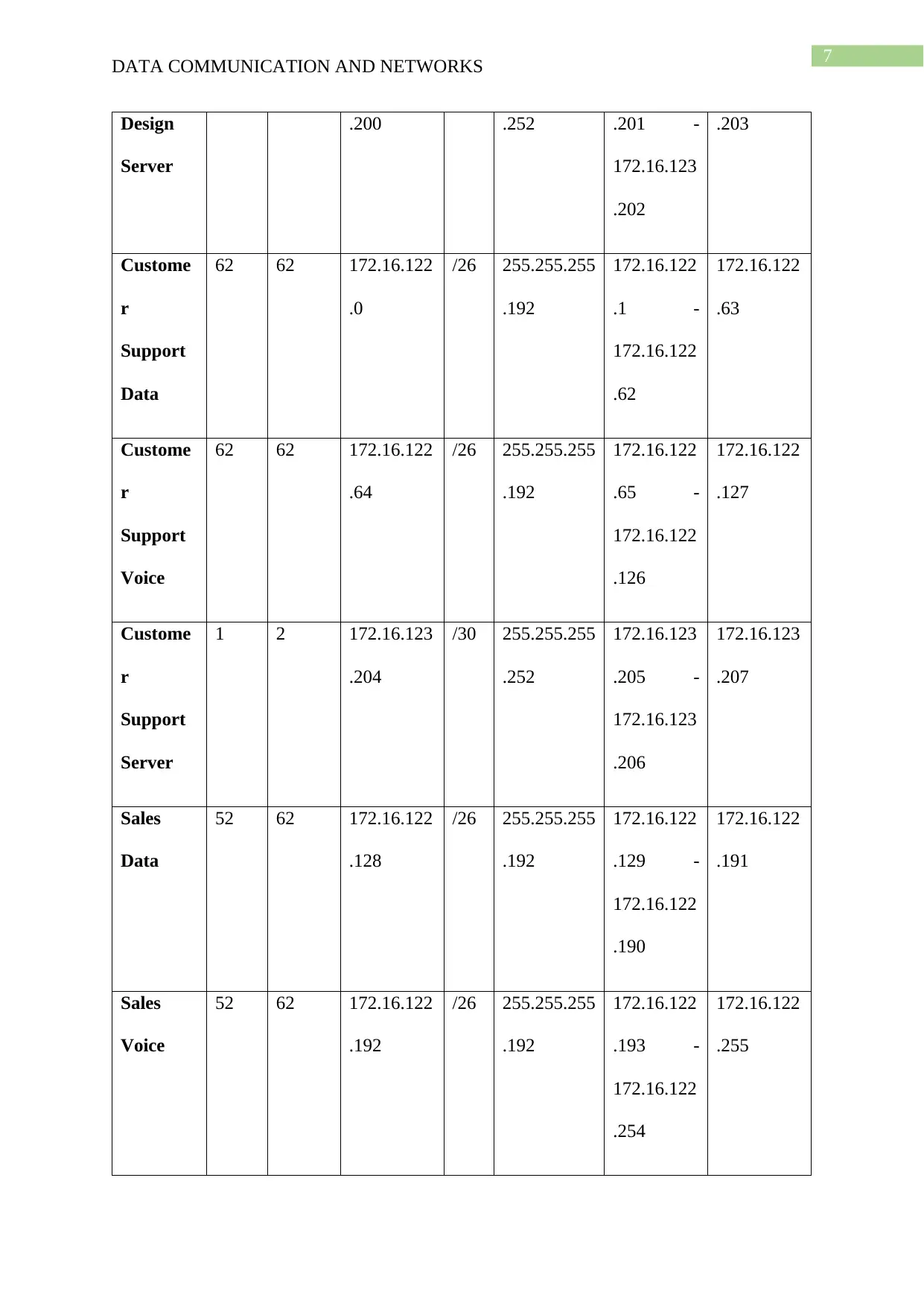
7
DATA COMMUNICATION AND NETWORKS
Design
Server
.200 .252 .201 -
172.16.123
.202
.203
Custome
r
Support
Data
62 62 172.16.122
.0
/26 255.255.255
.192
172.16.122
.1 -
172.16.122
.62
172.16.122
.63
Custome
r
Support
Voice
62 62 172.16.122
.64
/26 255.255.255
.192
172.16.122
.65 -
172.16.122
.126
172.16.122
.127
Custome
r
Support
Server
1 2 172.16.123
.204
/30 255.255.255
.252
172.16.123
.205 -
172.16.123
.206
172.16.123
.207
Sales
Data
52 62 172.16.122
.128
/26 255.255.255
.192
172.16.122
.129 -
172.16.122
.190
172.16.122
.191
Sales
Voice
52 62 172.16.122
.192
/26 255.255.255
.192
172.16.122
.193 -
172.16.122
.254
172.16.122
.255
DATA COMMUNICATION AND NETWORKS
Design
Server
.200 .252 .201 -
172.16.123
.202
.203
Custome
r
Support
Data
62 62 172.16.122
.0
/26 255.255.255
.192
172.16.122
.1 -
172.16.122
.62
172.16.122
.63
Custome
r
Support
Voice
62 62 172.16.122
.64
/26 255.255.255
.192
172.16.122
.65 -
172.16.122
.126
172.16.122
.127
Custome
r
Support
Server
1 2 172.16.123
.204
/30 255.255.255
.252
172.16.123
.205 -
172.16.123
.206
172.16.123
.207
Sales
Data
52 62 172.16.122
.128
/26 255.255.255
.192
172.16.122
.129 -
172.16.122
.190
172.16.122
.191
Sales
Voice
52 62 172.16.122
.192
/26 255.255.255
.192
172.16.122
.193 -
172.16.122
.254
172.16.122
.255
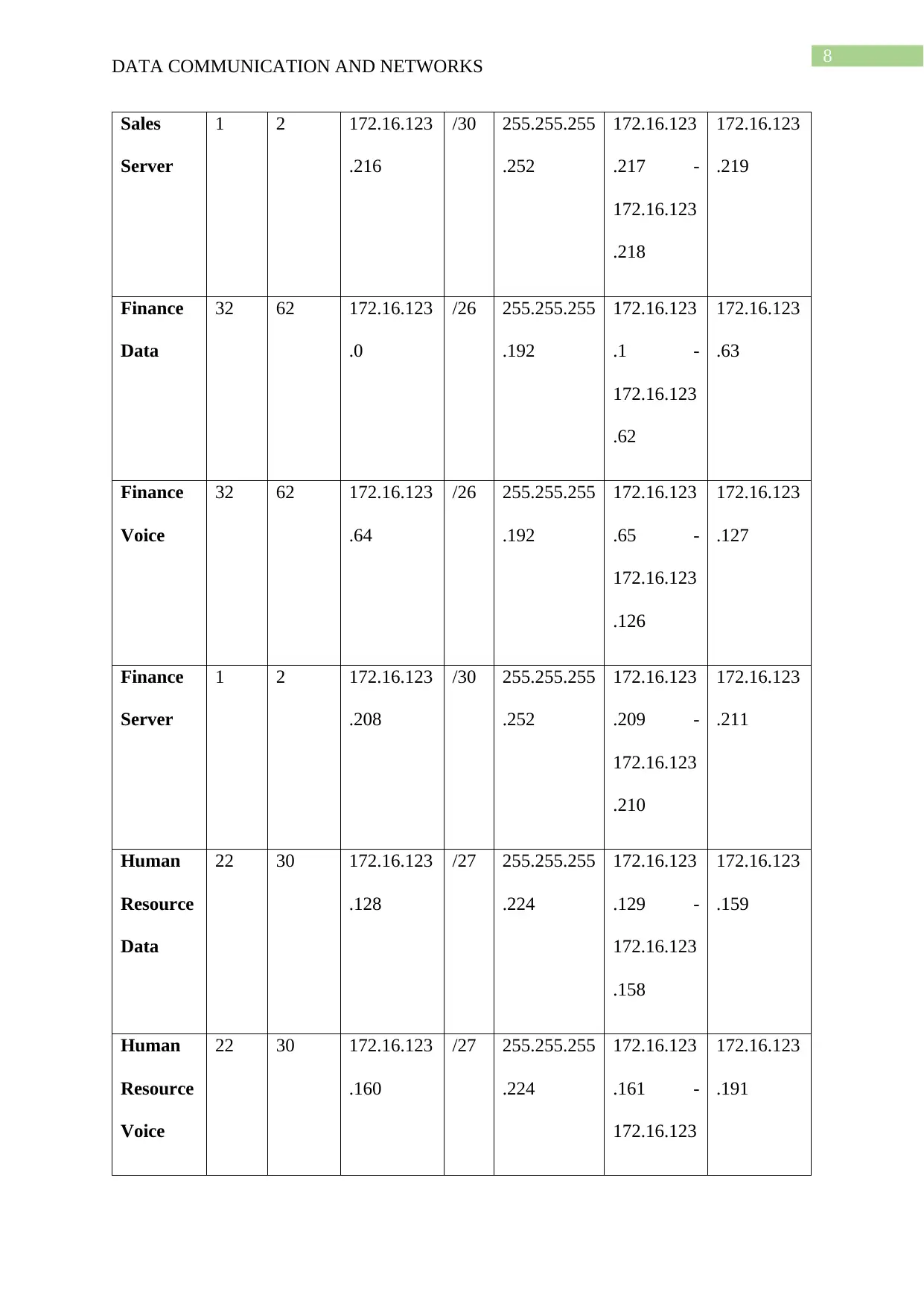
8
DATA COMMUNICATION AND NETWORKS
Sales
Server
1 2 172.16.123
.216
/30 255.255.255
.252
172.16.123
.217 -
172.16.123
.218
172.16.123
.219
Finance
Data
32 62 172.16.123
.0
/26 255.255.255
.192
172.16.123
.1 -
172.16.123
.62
172.16.123
.63
Finance
Voice
32 62 172.16.123
.64
/26 255.255.255
.192
172.16.123
.65 -
172.16.123
.126
172.16.123
.127
Finance
Server
1 2 172.16.123
.208
/30 255.255.255
.252
172.16.123
.209 -
172.16.123
.210
172.16.123
.211
Human
Resource
Data
22 30 172.16.123
.128
/27 255.255.255
.224
172.16.123
.129 -
172.16.123
.158
172.16.123
.159
Human
Resource
Voice
22 30 172.16.123
.160
/27 255.255.255
.224
172.16.123
.161 -
172.16.123
172.16.123
.191
DATA COMMUNICATION AND NETWORKS
Sales
Server
1 2 172.16.123
.216
/30 255.255.255
.252
172.16.123
.217 -
172.16.123
.218
172.16.123
.219
Finance
Data
32 62 172.16.123
.0
/26 255.255.255
.192
172.16.123
.1 -
172.16.123
.62
172.16.123
.63
Finance
Voice
32 62 172.16.123
.64
/26 255.255.255
.192
172.16.123
.65 -
172.16.123
.126
172.16.123
.127
Finance
Server
1 2 172.16.123
.208
/30 255.255.255
.252
172.16.123
.209 -
172.16.123
.210
172.16.123
.211
Human
Resource
Data
22 30 172.16.123
.128
/27 255.255.255
.224
172.16.123
.129 -
172.16.123
.158
172.16.123
.159
Human
Resource
Voice
22 30 172.16.123
.160
/27 255.255.255
.224
172.16.123
.161 -
172.16.123
172.16.123
.191
⊘ This is a preview!⊘
Do you want full access?
Subscribe today to unlock all pages.

Trusted by 1+ million students worldwide
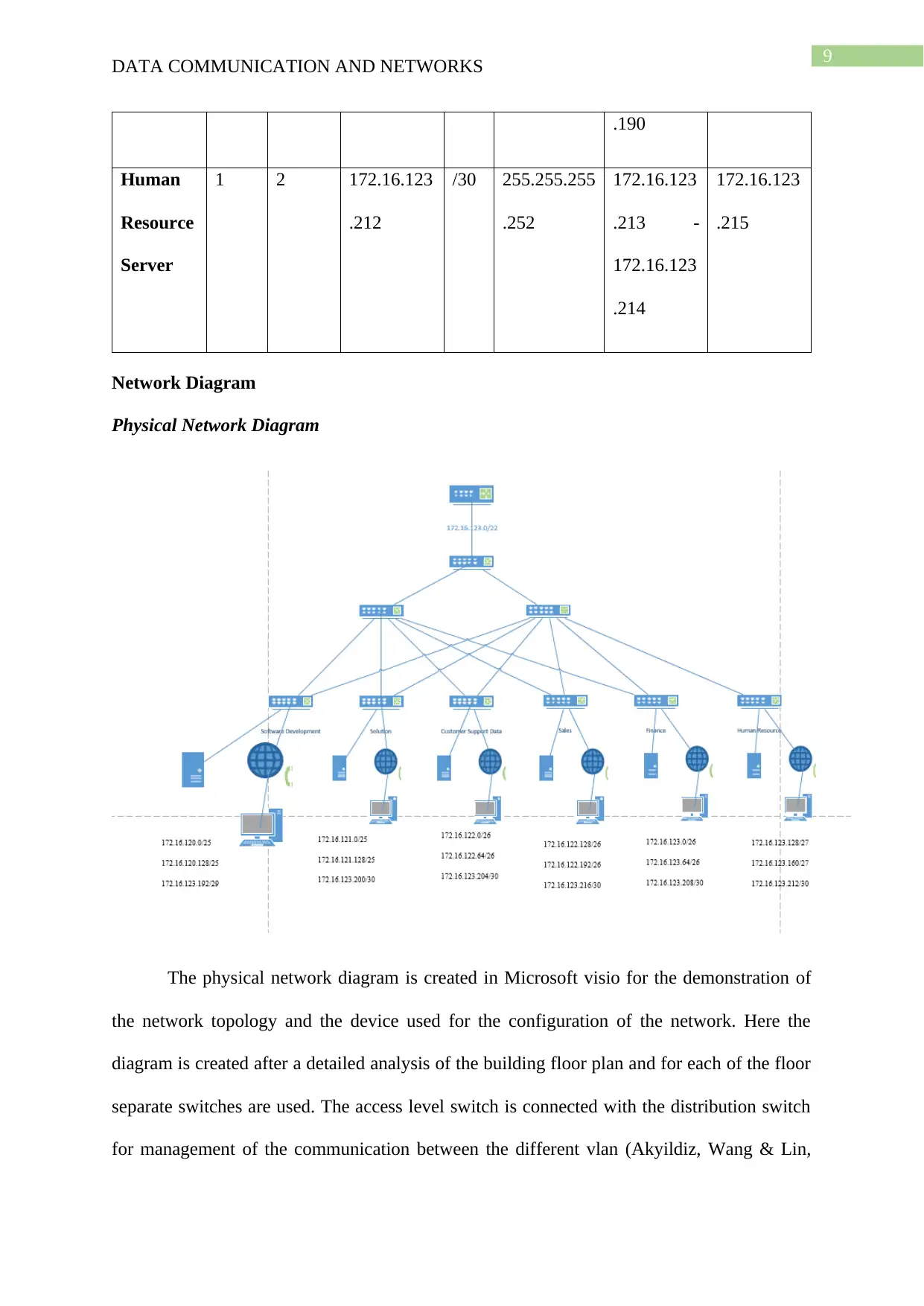
9
DATA COMMUNICATION AND NETWORKS
.190
Human
Resource
Server
1 2 172.16.123
.212
/30 255.255.255
.252
172.16.123
.213 -
172.16.123
.214
172.16.123
.215
Network Diagram
Physical Network Diagram
The physical network diagram is created in Microsoft visio for the demonstration of
the network topology and the device used for the configuration of the network. Here the
diagram is created after a detailed analysis of the building floor plan and for each of the floor
separate switches are used. The access level switch is connected with the distribution switch
for management of the communication between the different vlan (Akyildiz, Wang & Lin,
DATA COMMUNICATION AND NETWORKS
.190
Human
Resource
Server
1 2 172.16.123
.212
/30 255.255.255
.252
172.16.123
.213 -
172.16.123
.214
172.16.123
.215
Network Diagram
Physical Network Diagram
The physical network diagram is created in Microsoft visio for the demonstration of
the network topology and the device used for the configuration of the network. Here the
diagram is created after a detailed analysis of the building floor plan and for each of the floor
separate switches are used. The access level switch is connected with the distribution switch
for management of the communication between the different vlan (Akyildiz, Wang & Lin,
Paraphrase This Document
Need a fresh take? Get an instant paraphrase of this document with our AI Paraphraser
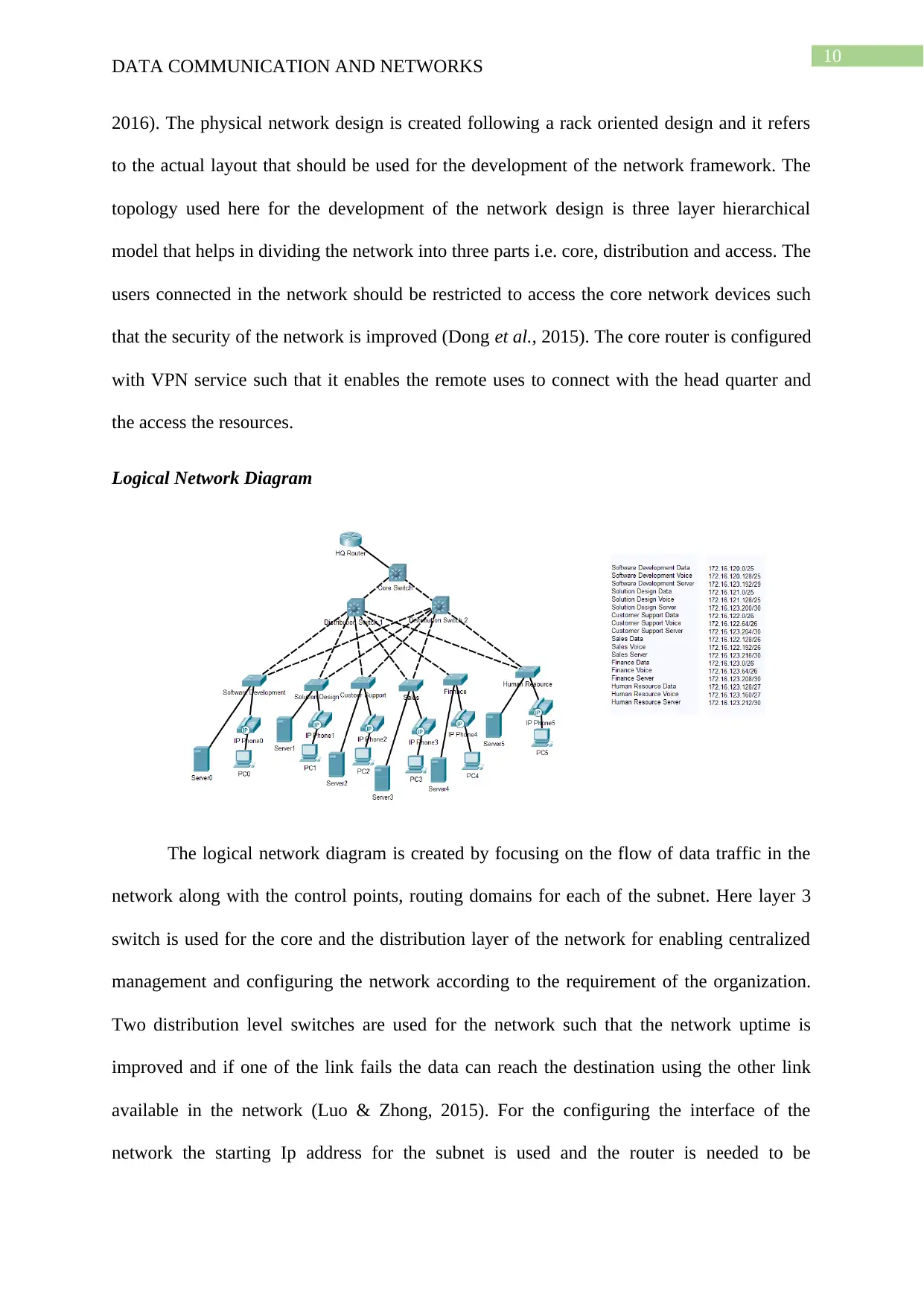
10
DATA COMMUNICATION AND NETWORKS
2016). The physical network design is created following a rack oriented design and it refers
to the actual layout that should be used for the development of the network framework. The
topology used here for the development of the network design is three layer hierarchical
model that helps in dividing the network into three parts i.e. core, distribution and access. The
users connected in the network should be restricted to access the core network devices such
that the security of the network is improved (Dong et al., 2015). The core router is configured
with VPN service such that it enables the remote uses to connect with the head quarter and
the access the resources.
Logical Network Diagram
The logical network diagram is created by focusing on the flow of data traffic in the
network along with the control points, routing domains for each of the subnet. Here layer 3
switch is used for the core and the distribution layer of the network for enabling centralized
management and configuring the network according to the requirement of the organization.
Two distribution level switches are used for the network such that the network uptime is
improved and if one of the link fails the data can reach the destination using the other link
available in the network (Luo & Zhong, 2015). For the configuring the interface of the
network the starting Ip address for the subnet is used and the router is needed to be
DATA COMMUNICATION AND NETWORKS
2016). The physical network design is created following a rack oriented design and it refers
to the actual layout that should be used for the development of the network framework. The
topology used here for the development of the network design is three layer hierarchical
model that helps in dividing the network into three parts i.e. core, distribution and access. The
users connected in the network should be restricted to access the core network devices such
that the security of the network is improved (Dong et al., 2015). The core router is configured
with VPN service such that it enables the remote uses to connect with the head quarter and
the access the resources.
Logical Network Diagram
The logical network diagram is created by focusing on the flow of data traffic in the
network along with the control points, routing domains for each of the subnet. Here layer 3
switch is used for the core and the distribution layer of the network for enabling centralized
management and configuring the network according to the requirement of the organization.
Two distribution level switches are used for the network such that the network uptime is
improved and if one of the link fails the data can reach the destination using the other link
available in the network (Luo & Zhong, 2015). For the configuring the interface of the
network the starting Ip address for the subnet is used and the router is needed to be
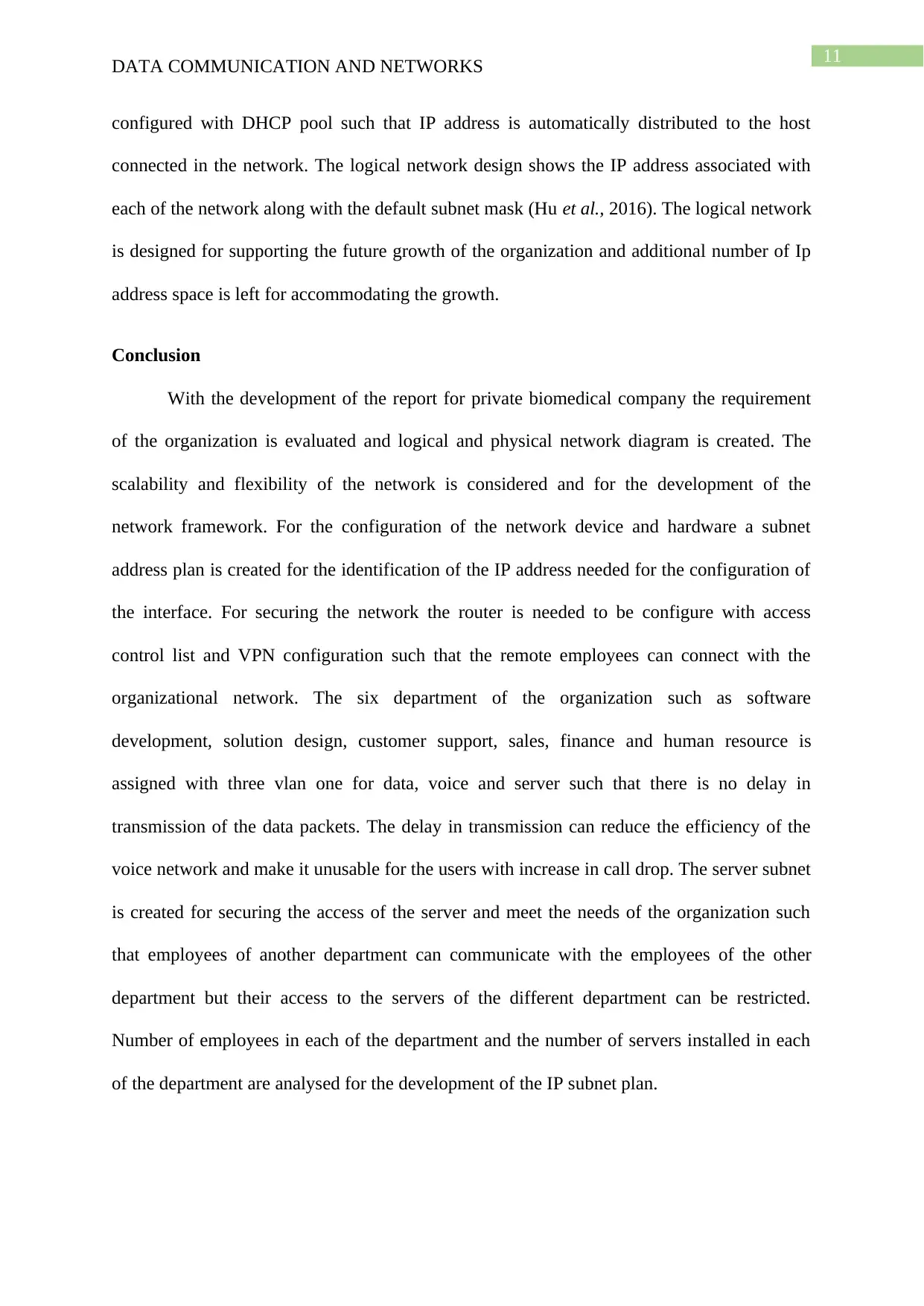
11
DATA COMMUNICATION AND NETWORKS
configured with DHCP pool such that IP address is automatically distributed to the host
connected in the network. The logical network design shows the IP address associated with
each of the network along with the default subnet mask (Hu et al., 2016). The logical network
is designed for supporting the future growth of the organization and additional number of Ip
address space is left for accommodating the growth.
Conclusion
With the development of the report for private biomedical company the requirement
of the organization is evaluated and logical and physical network diagram is created. The
scalability and flexibility of the network is considered and for the development of the
network framework. For the configuration of the network device and hardware a subnet
address plan is created for the identification of the IP address needed for the configuration of
the interface. For securing the network the router is needed to be configure with access
control list and VPN configuration such that the remote employees can connect with the
organizational network. The six department of the organization such as software
development, solution design, customer support, sales, finance and human resource is
assigned with three vlan one for data, voice and server such that there is no delay in
transmission of the data packets. The delay in transmission can reduce the efficiency of the
voice network and make it unusable for the users with increase in call drop. The server subnet
is created for securing the access of the server and meet the needs of the organization such
that employees of another department can communicate with the employees of the other
department but their access to the servers of the different department can be restricted.
Number of employees in each of the department and the number of servers installed in each
of the department are analysed for the development of the IP subnet plan.
DATA COMMUNICATION AND NETWORKS
configured with DHCP pool such that IP address is automatically distributed to the host
connected in the network. The logical network design shows the IP address associated with
each of the network along with the default subnet mask (Hu et al., 2016). The logical network
is designed for supporting the future growth of the organization and additional number of Ip
address space is left for accommodating the growth.
Conclusion
With the development of the report for private biomedical company the requirement
of the organization is evaluated and logical and physical network diagram is created. The
scalability and flexibility of the network is considered and for the development of the
network framework. For the configuration of the network device and hardware a subnet
address plan is created for the identification of the IP address needed for the configuration of
the interface. For securing the network the router is needed to be configure with access
control list and VPN configuration such that the remote employees can connect with the
organizational network. The six department of the organization such as software
development, solution design, customer support, sales, finance and human resource is
assigned with three vlan one for data, voice and server such that there is no delay in
transmission of the data packets. The delay in transmission can reduce the efficiency of the
voice network and make it unusable for the users with increase in call drop. The server subnet
is created for securing the access of the server and meet the needs of the organization such
that employees of another department can communicate with the employees of the other
department but their access to the servers of the different department can be restricted.
Number of employees in each of the department and the number of servers installed in each
of the department are analysed for the development of the IP subnet plan.
⊘ This is a preview!⊘
Do you want full access?
Subscribe today to unlock all pages.

Trusted by 1+ million students worldwide
1 out of 14
Related Documents
Your All-in-One AI-Powered Toolkit for Academic Success.
+13062052269
info@desklib.com
Available 24*7 on WhatsApp / Email
![[object Object]](/_next/static/media/star-bottom.7253800d.svg)
Unlock your academic potential
Copyright © 2020–2025 A2Z Services. All Rights Reserved. Developed and managed by ZUCOL.




